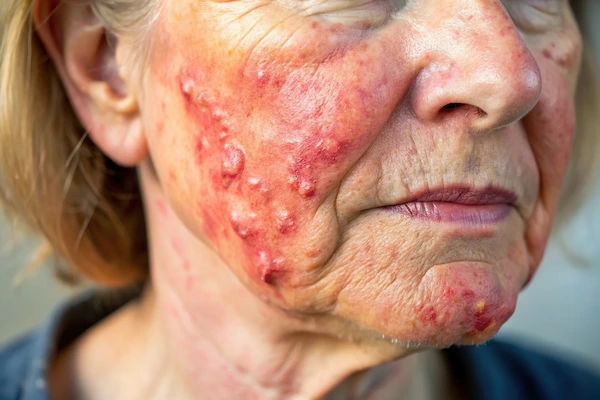Understanding Radiation Therapy Types And Side Effects
Radiation therapy is a common, effective cancer treatment. Learn about the main types—External Beam (EBRT) and Brachytherapy—how they work, advanced options like SBRT and Proton Therapy, and essential tips for managing common side effects like fatigue and skin changes


Introduction
Radiation therapy is one of the most common and effective treatments for cancer, used in about half of all cancer care plans to shrink tumours, relieve symptoms, or help prevent cancer from returning.1 Yet “radiation,” “therapy,” and “types” can sound confusing when you’re trying to understand what to expect. This guide breaks it down in clear, everyday language.
We’ll walk you through how radiation therapy works, the main types—external beam radiation therapy (EBRT), internal radiation (brachytherapy), and advanced options like proton therapy and stereotactic treatments—and the side effects you might experience, from short-term fatigue and skin changes to possible long-term effects. You’ll learn what the treatment journey looks like, how to prepare, and practical tips to feel better during and after therapy. Where helpful, we’ll share examples and data from trusted cancer organisations, and point you to questions worth asking your radiation oncologist.
If you’re newly diagnosed, supporting a loved one, or preparing for radiation, this article will help you make sense of the options, weigh risks and benefits, and move forward with confidence.
Consult a Top General Practitioner for Personalised Advice
Radiation Therapy at a Glance
This treatment uses high-energy beams to damage cancer cells and is a core component of modern cancer care.2
Radiation therapy uses high-energy beams to damage the DNA inside cancer cells so they stop dividing and eventually die.3 It can be used alone or alongside surgery, chemotherapy, targeted therapy, hormone therapy, or immunotherapy, depending on the cancer type and stage.4 Broadly, there are three types: external beam radiation therapy (EBRT) delivered from a machine outside the body; internal radiation (brachytherapy) where a radioactive source is placed inside the body; and systemic radiation using radioactive drugs that travel throughout the body.
How common is radiation in cancer care? Authoritative sources estimate that about 50–60% of people with cancer will receive some form of radiation therapy during their treatment journey. It’s used to cure cancer (curative intent), control growth (definitive or adjuvant therapy), or relieve symptoms like pain or bleeding (palliative radiation therapy).5
Benefits and limits: Modern radiation is precise, but not all cancers respond the same way. Tumours that are well-defined and localised are typically good candidates.6 Some cancers are more sensitive (radiosensitive), while others are less so.7 Importantly, side effects vary by treatment site, total dose, fractionation schedule, and whether radiation is combined with other therapies such as chemotherapy.8 Radiation doesn’t make you “radioactive” with standard EBRT, and most people can safely be around family and pets after treatment.9 If symptoms persist beyond two weeks during or after therapy, consult a doctor online with Apollo24|7 for further evaluation and timely support.
How Radiation Therapy Works
Radiation damages cancer cell DNA, and it's delivered in small, precise daily doses to allow healthy cells to recover.10
At its core, radiation works by damaging DNA in cancer cells.11 The damage can be direct or via free radicals formed when radiation interacts with water in cells.12 Because cancer cells tend to divide rapidly and have weaker repair mechanisms, they’re more likely to die or stop dividing. Healthy cells can repair better, especially when radiation is delivered in small daily doses—a concept called fractionation.
Precision and Planning
Precision matters. Radiation oncologists use a planning CT (sometimes MRI or PET) to outline the tumour and nearby normal tissues.The dosimetrist and physicist help design a plan that concentrates dose to the tumour (the planning target volume) while protecting “organs at risk” (OAR) like the heart, lungs, salivary glands, bowel, or spinal cord. Image guidance (IGRT) helps ensure daily accuracy by checking alignment with X-rays, cone-beam CT, or surface imaging before treatment.
Schedules and Fractionation
Many treatments are given Monday through Friday over several weeks. Hypofractionation uses a slightly higher dose per session over fewer sessions and is now common in breast and prostate cancer when appropriate, supported by strong evidence. For small, well-defined targets, stereotactic body radiation therapy (SBRT) or stereotactic radiosurgery (SRS) delivers very high precision in 1–5 sessions.
Unique insight: Technology vs technique. IMRT, IGRT, and proton therapy are technologies; SBRT is a technique (an approach to dose, precision, and safety). The best plan blends both—matching technology to technique based on tumour location and goals.
Main Types: External Beam Radiation Therapy (EBRT)
EBRT is the most common method, using a machine outside the body to deliver targeted X-rays or electrons.
EBRT is the most common method. A linear accelerator delivers high-energy X-rays or electrons from outside the body.
You do not feel the beam, and each session typically lasts 10–20 minutes.
Key EBRT Techniques
- 3D-CRT (three-dimensional conformal radiation therapy): Uses 3D imaging to shape beams around the tumour.
- IMRT (intensity-modulated radiation therapy): Varies the beam intensity across different areas, sculpting dose around
critical structures (e.g., sparing salivary glands in head & neck cancer). - IGRT (image-guided radiation therapy): Adds frequent imaging to confirm positioning, reducing setup errors and margins.
- SBRT (stereotactic body radiation therapy): Pinpoint, high-dose treatments in fractions for small tumours (e.g., early-stage lung, certain spine or liver lesions) with local control rates that can exceed 85–90% in selected cases.
- SRS (stereotactic radiosurgery): A single or few high-dose sessions to brain targets (e.g., metastases), often an alternative to whole-brain radiation in select cases.
Real-world examples
- Breast cancer: Hypofractionated IMRT/3D-CRT over 3–4 weeks is common, sometimes with a “boost” to the tumour bed. Modern planning reduces heart and lung dose, especially for left-sided tumours.
- Prostate cancer: IMRT with IGRT allows higher tumour dose while sparing bladder and rectum; SBRT in 5 sessions is an option for low/intermediate risk in many centres.26
- Head & neck cancers: IMRT helps protect salivary glands and swallowing muscles, reducing long-term dry mouth and swallowing problems.27
Unique insight: Breath-hold techniques for left-sided breast cancer (deep inspiration breath hold) can meaningfully reduce heart dose—ask if your centre offers it.28
Main Types: Internal Radiation (Brachytherapy)
Brachytherapy delivers radiation directly inside or next to the tumour using a temporarily or permanently placed
radioactive source.
Brachytherapy places a radiation source directly inside or next to the tumour, delivering a high dose to the target while
limiting exposure to nearby organs. It can be:
- Temporary (high-dose-rate, HDR): A source is placed via applicators or catheters for minutes and then removed.
- Permanent (low-dose-rate, LDR): Tiny radioactive seeds are implanted and emit radiation over weeks to months before becoming inactive.
Common Uses
- Gynaecologic cancers (cervix, uterus, vagina): HDR brachytherapy after external beam therapy is standard in many cases and improves tumour control.
- Prostate cancer: LDR permanent seed implants for low-risk disease, or HDR temporary implants in combination with
EBRT for higher-risk cases. - Skin and other sites: Brachytherapy can target small, superficial lesions with excellent cosmetic outcomes.
Safety around family
With HDR, there’s no radioactivity left in the body after each session. With permanent seeds, radiation levels are low, but patients may receive short-term precautions (e.g., avoid prolonged close contact with small children or pregnant people for a defined period). Your team provides clear, time-limited guidance.
Unique insight: Brachytherapy success depends on expert placement and imaging guidance. If you’re a candidate, ask about your centre’s experience, imaging (ultrasound/MRI) during placement, and dose constraints for organs at risk.
Advanced Modalities and Special Situations
Advanced options, such as Proton Therapy and SBRT, offer increased precision for specific tumour locations and patient needs.
- Proton therapy: Protons deposit most of their energy at a specific depth (the Bragg peak), potentially reducing exit dose
beyond the tumour. This can be particularly useful in paediatric cancers (to reduce long-term effects), certain skull base
tumours, or when critical organs are close to the target. Proton availability varies by region, and not all cases benefit
equally—selection is key. - IORT (intraoperative radiation therapy): Delivers a single high dose during surgery to a precisely visualised area (e.g., select breast or sarcoma cases). It may shorten overall treatment time and protect nearby organs by moving them out of the field in the operating room.
- TBI (total body irradiation): Used mainly before stem cell transplant to suppress the immune system and eliminate cancer cells in blood malignancies.
- Systemic radiation: Radioactive drugs travel through the bloodstream. Examples include radioactive iodine (I-131) for differentiated thyroid cancer, radium-223 for symptomatic bone metastases in prostate cancer, and certain peptide receptor radionuclide therapies (PRRT) for neuroendocrine tumours (availability varies). These are often managed by nuclear medicine teams, sometimes in partnership with radiation oncology.
Unique insight: “Best” doesn’t always mean “most advanced.” The best therapy is the one that matches your tumour biology, location, and goals, delivered by a team experienced in that modality.
The Patient Journey: From Consult to Last Fraction
The journey involves consultation, precise planning (simulation), daily quick treatments, and regular symptom checks.
The first visit
You’ll meet a radiation oncologist who reviews your history, scans, pathology, and other treatments (surgery, chemo).
They’ll explain intent (curative vs palliative), recommend a type of radiation, and discuss likely side effects. You may
meet a nurse, therapist, and possibly a dietitian or speech/swallow specialist (for head & neck).
Simulation and planning
“Sim” is a specialised CT scan in the treatment position. Custom immobilisation (moulds, masks for head/neck)
ensures reproducibility. Skin marks or tiny tattoos may guide alignment. Planners contour the tumour and organs at
risk; the dosimetrist designs beam angles and intensity; the physicist ensures the plan is safe and accurate. This planning phase can take several days.
Daily treatment
Treatments are typically Monday–Friday. Each session includes setup, quick imaging (IGRT), and delivery from
multiple angles. You won’t feel the beam, and sessions are painless. Weekly, you’ll have an “on-treatment visit” to manage side effects. Report changes like skin irritation, swallowing discomfort, diarrhoea, or new fatigue early—tiny adjustments, medicines, or supportive care make a big difference.
Practical prep and support
- Bring a symptom diary.
- Wear loose, soft clothing over treated areas.
- Maintain regular, gentle activity (short walks help fatigue).
- Ask about dental evaluation before head & neck radiation to prevent dental complications.
- If your condition does not improve after trying these methods, book a physical visit to a doctor with Apollo24|7 for timely support.
Unique insight: Consistency beats perfection. Completing the planned schedule as designed helps outcomes; if you must miss a day, ask about “make-up” sessions so the overall course stays effective.
Side Effects: What to Expect and How to Cope
Acute side effects like fatigue and skin irritation are common but usually manageable with proactive care and medical
support.
Short-term (acute) side effects usually develop during treatment or within a few weeks after finishing. Common ones include:
- Fatigue: The most frequent side effect. Gentle exercise, hydration, and consistent sleep help. Track fatigue severity and share with your team—a thyroid function test may be considered after neck irradiation if fatigue persists. Apollo 24|7 offers convenient home collection for tests like TSH if your care team recommends monitoring
- Skin changes (radiation dermatitis): Redness, dryness, itching, or peeling in the treated area.57 Use gentle, fragrance-free moisturisers; avoid tight clothing; protect from the sun. Your team may recommend specific creams or dressings.
Site-specific effects:
- Breast/chest: Mild swelling, breast tenderness, skin tanning; rare “radiation recall” if certain chemo drugs are used
later.58 - Pelvis: Urinary urgency/frequency, diarrhoea, rectal irritation; hydration and a low-fibre “BRAT”-style diet may help during flares.
- Head & neck: Sore throat, mouth sores, dry mouth (xerostomia), taste changes; rigorous oral care, bland diet, saliva substitutes, and pain control are essential.
- Abdomen: Nausea; small, frequent, bland meals and antiemetics can help.
Working with your team
- Report symptoms early; side-effect control is proactive.
- Ask about evidence-based skin care protocols and mouth care kits.
- If symptoms such as severe pain, high fever, persistent vomiting, or bleeding occur, seek urgent care. If symptoms
persist beyond two weeks, consult a doctor online with Apollo24|7 for further evaluation.
Unique insight: Many centres provide “prehabilitation” (nutrition, exercise, dental) before radiation—ask if yours does. Early preparation reduces complications and helps you stay on schedule.
Long-Term and Late Effects, Fertility, and Follow-Up
Late effects can emerge months to years after treatment, requiring ongoing monitoring and survivorship care.
Late effects may appear months to years later and depend on the treated area, dose, and individual factors. Potential
concerns include:
- Heart and lungs: With left-sided breast or chest radiation, modern planning aims to minimise heart and lung dose; ask about breath-hold techniques and dose constraints.63
- Thyroid: Neck radiation can raise the risk of hypothyroidism; periodic TSH testing is standard in follow-up. If access is challenging, Apollo 24|7 offers home collection for thyroid blood tests as advised by your doctor.
- Bones: Risk of rib or pelvic bone thinning/fracture after high-dose fields; weight-bearing exercise and bone health management help.
- Lymphatic system: Risk of lymphoedema in the arm after breast/axilla radiation; early referral to physical therapy is beneficial
- Nerves and soft tissues: Rare fibrosis or nerve irritation causing stiffness or numbness.
- Fertility and sexual health: Pelvic radiation can affect ovarian or testicular function and vaginal/penile tissues; discuss sperm banking, egg/embryo freezing, ovarian transposition, and vaginal dilator use before treatment when relevant.
- Secondary cancers: Very low risk with modern techniques; benefits generally far outweigh this risk in indicated cases.
Survivorship planning
- Ask for a treatment summary and survivorship care plan: what was treated, doses, and which tests to schedule over
time. - Tell new healthcare providers you had radiation and which area was treated.
Unique insight: Consider “baseline” tests (e.g., dental, thyroid, cardiac if left chest treated) before or soon after radiation
so your team can spot and manage changes early.
Safety, Myths, and Making Good Decisions
Standard external beam radiation doesn't make you radioactive, and the benefits of treatment usually outweigh the
minimal risks.69
Radiation safety and daily life
- You’re not radioactive after EBRT; it’s safe to be with family and pets.
- With certain implants (LDR seeds) or systemic therapies, you may get temporary precautions; follow the printed instructions your team provides.
Myths vs facts
- Myth: Radiation always causes severe sickness. Fact: Many people continue working with adjustments; side effects are
manageable for most, with proper support.71 - Myth: More dose is always better. Fact: The right dose balances tumour control and normal tissue safety.
Conclusion
Radiation therapy has evolved into a highly precise, customisable tool that can cure cancer, control growth, or relieve symptoms—often working seamlessly with surgery, chemotherapy, or other treatments.72 Understanding the main types—external beam radiation therapy, internal brachytherapy, and select advanced options like SBRT/SRS or proton therapy—helps you make informed choices aligned with your goals and values.
Side effects are real but manageable for most people when identified early. Your team’s planning expertise, use of image guidance, and supportive care (skin care, nutrition, dental/oral care, physical therapy) can make a meaningful difference in both short-term comfort and long-term health. Ask clear questions about intent, technique, organs at risk, and follow-up testing (e.g., thyroid after neck radiation). Keep a symptom diary and speak up if anything changes.
If you’re starting or considering radiation, take a moment to write down your questions and bring a support person to your consult. If symptoms persist beyond two weeks or you need guidance between visits, consult a doctor online with Apollo 24|7 for practical, timely advice. With the right plan and support, many people complete therapy while maintaining quality of life—and that is a victory in itself.
Consult a Top General Practitioner for Personalised Advice
Consult a Top General Practitioner for Personalised Advice

Dr. Tanmaya Kumar Sahu
General Physician/ Internal Medicine Specialist
12 Years • MBBS, MD ( Internal Medicine )
Bhubaneswar
Apollo Hospitals Old Sainik School Road, Bhubaneswar

Dr. Bulbul Biswas
General Practitioner
35 Years • MBBS, Diploma in Maternity and child welfare
Kolkata
HERSTEL CARE CLINIC, Kolkata
Dr. Lt Col Rakesh Bhatia
General Practitioner
22 Years • MBBS
GAUTAM BUDH NAGAR
SEHAT CLINIC, GAUTAM BUDH NAGAR

Dr. Avinash Pasuparthy
General Practitioner
5 Years • MBBS
Visakhapatnam
Apollo Clinic Vizag, Visakhapatnam

Dr. Ravikumar Bn
General Practitioner
20 Years • MBBS , MD (Bio-chemistry)
Secunderabad
SURAKSHIT POLY CLINIC, Secunderabad
Consult a Top General Practitioner for Personalised Advice

Dr. Tanmaya Kumar Sahu
General Physician/ Internal Medicine Specialist
12 Years • MBBS, MD ( Internal Medicine )
Bhubaneswar
Apollo Hospitals Old Sainik School Road, Bhubaneswar

Dr. Bulbul Biswas
General Practitioner
35 Years • MBBS, Diploma in Maternity and child welfare
Kolkata
HERSTEL CARE CLINIC, Kolkata
Dr. Lt Col Rakesh Bhatia
General Practitioner
22 Years • MBBS
GAUTAM BUDH NAGAR
SEHAT CLINIC, GAUTAM BUDH NAGAR

Dr. Avinash Pasuparthy
General Practitioner
5 Years • MBBS
Visakhapatnam
Apollo Clinic Vizag, Visakhapatnam

Dr. Ravikumar Bn
General Practitioner
20 Years • MBBS , MD (Bio-chemistry)
Secunderabad
SURAKSHIT POLY CLINIC, Secunderabad
More articles from General Medical Consultation
Frequently Asked Questions
1) Is radiation therapy painful?
The treatment itself is painless. You might feel side effects like skin irritation or fatigue over time. Managing radiation fatigue with gentle exercise and rest can help; report symptoms early.
2) How long does a typical course take?
Most external beam courses run 3–7 weeks with daily sessions; hypofractionation shortens this for certain cancers. Stereotactic body radiation therapy (SBRT) is often 1–5 sessions.
3) What are the most common side effects?
Fatigue and skin changes are common. Site-specific effects include mouth/throat soreness (head & neck), diarrhoea (pelvis), or nausea (abdomen).78 Skin care during radiation therapy and good hydration are helpful.
4) Is proton therapy better than IMRT for everyone?
Not necessarily. Proton therapy can reduce dose to organs at risk in selected cases (e.g., paediatric, skull base), but IMRT remains excellent for many tumours. Discuss IMRT vs proton therapy with your team.
5) Will I be radioactive around my family?
Not after standard external beam radiation therapy. With permanent brachytherapy seeds or systemic radioisotopes, you may receive short-term precautions.




